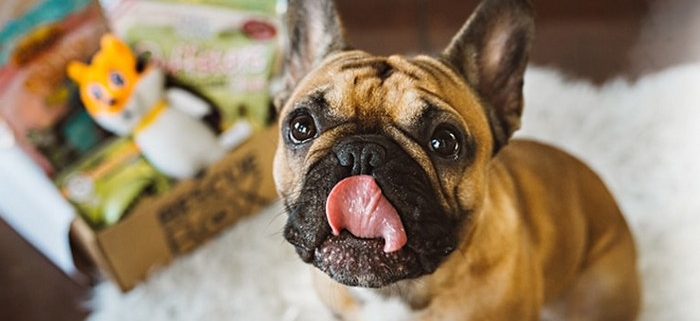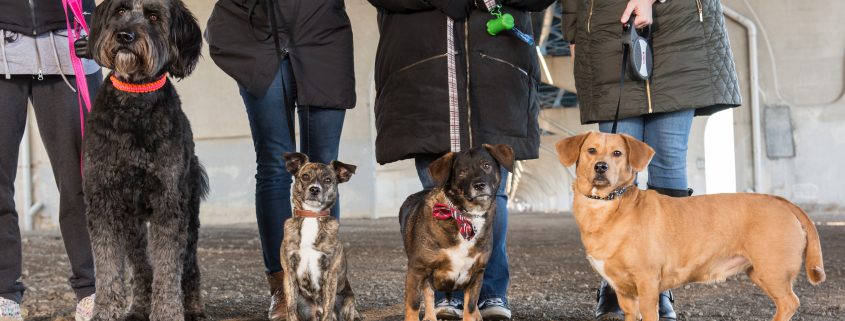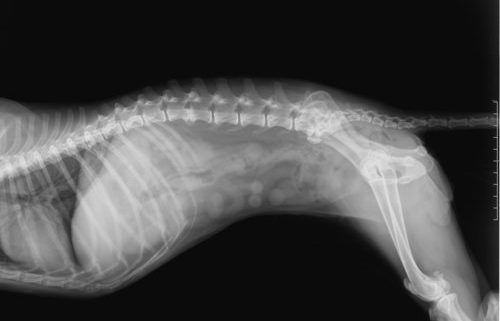By CHERESE COBB
Don’t hog all the mail wealth: treat your pooch to one of these five subscription boxes. Stuffed with mouth-watering treats, cuddly plush toys and adjustable accessories, they’re gifts that keep on giving—in licks, cuddles and tail wags.
1. BarkBox
Cost: $29 per month
Shipping: Free to the United States and Canada
Coupon: Use the code RWPCH0LSSR for a free month of products
What’s inside:
The leader of the monthly dog box pack in both sales and name recognition, BarkBox is one of the least expensive services that you’ll find. Offering a multi-dog discount, the company even donates 10 percent of its proceeds to roughly 3,000 different rescues. Featuring monthly themes like Bento Blossoms, Sniffin’ Safari, and Chewrassic Bark, BarkBox includes at least two innovative toys, two all-natural bags of treats, and a heavy-duty chew toy. “The monthly toy selection…is always a plush item. It makes your pooch’s toy chest start to remind you of ‘The Claw’ game at the local arcade,” says Aasit Thakkar, a current BarkBox subscriber. “I’d prefer my pooch to enjoy toys of different natures, i.e., balls, puzzles, ropes, tossers etc. If BarkBox offered either more challenging or fun toys…then I’d say the service is truly worth barking about.” However, if a toy or treat doesn’t get your dog’s tail wagging, BarkBox will send a replacement for free. “No muss. No fuss. No disappointed pups.”
2. Pet Gift Box
Cost: $24.99 per month with
free shipping in the United States,
excluding Hawaii and Alaska
Coupon: Use the code FETCH
for $5 off
What’s Inside:
Pretested on pets for “paw prints of satisfaction,” Pet Gift Box offers six toys and treats themed around the relevant holidays. Whether you have a small, medium or large pet, you can choose a one-time, 3-month or 12-month subscription. Cats will receive balls, catnip-filled toys, catnip and feathery chasers, while dogs get balls and plush, stuffingless or waterproof toys. “My dogs [Christopher and Danny], being both greedy and toy-obsessed, soon worked out that they could open the box with their nose by flipping the lid…so it had to be kept out of reach,” says Kim O’Meara, a Pet Gift Box customer. Every box looks like a gift with a bow and supports Pets for Patriots, Family Reach, and Music Drives Us.
3. RescueBox
Cost: $29.95 per month
Shipping: A $5.95 flat-rate fee is
applied to orders outside of the
contiguous 48 states
What’s Inside: “My dog, Diamond, gets extremely excited each month when her RescueBox comes in the mail,” says Ashley Jacobs, the founder of Sitting for a Cause. “She loves to rip it open, tear the paper wrapping to shreds, and play with her new toys.” Depending on whether you have a cat or a small, medium, or large-sized dog, every month the RescueBox team will handpick five toys and treats. Every delivery also features a rescue story that’s only possible because of the generous donations of subscribers. “What I love most about the box…they will tell you the impact your subscription has had. Since subscribing to RescueBox in October of 2016, they have donated 80 bowls of food and 32 vaccines to shelter animals.”
4. PupJoy
Cost: $26 per month
Shipping: Free shipping to the
lower 48 states
What’s Inside:
“A finalist for the 2018 Purina Pet Care Innovation Prize, PupJoy has a very transparent charitable donation model to help support animal rescue, in partnership with the BISSELL Pet Foundation,” says Dustin McAdams, the founder and CEO. “We donate $2 on every order and 100 percent of the donated money goes directly to help over 3000 rescue organizations that they work with.” PupJoy also has the most personalized model available for dog parents. After choosing an Uno or Grande (small or large) box, you can specify the type of items that you want: accessories, toys and treats, including all-natural and organic options. Depending on what stage of life your dog is going through, you’ll get five to seven products valued at over $40. For example, if your dog is a chew-inator, you’ll get virtually indestructible chew toys, or if your dog is in potty-training mode, you may get extra pee spray. “PupJoy’s toys are the kind of stuff I would expect to see in an expensive dog boutique in New York City,” says Amanda, the owner of Shiloh Shepherd’s Luna Rae and Nova Mae. “The treats…have straight-forward ingredients and a small business vibe. They all have ingredients that would be edible for us humans too!”
5. Bullymake
Cost: $39 per month
Shipping: Free to the US and $8
to Canada
What’s Inside:
A monthly subscription box for power chewers, Bullymake never sends plush toys or rawhide, which can cause choking, blockage and diarrhea. Instead, the team sends two to three extremely durable toys and three to four treats, chews and healthy edibles. While the treats are hand-selected based on your dog’s allergies and size, you can opt for a “toys-only” box. “While I wish that it [the default subscription box] was more heavily weighted on the toy-side rather than the treat, I also appreciate that Bullymake always sends one long-term chew treat—it’s a good way to occupy one of my dogs for a few hours,” says Christine Massey, a long-time Bullymake customer. Even if your ruff and tuff pup continues to turn his or her adorable toys into ripped-up rags, under the Bullymake 100 Percent Guarantee, they’ll ship you a replacement that’s rougher and tougher for free.
Did your favorite dog subscription box make the list? Let us know at info@fetchmag.com








